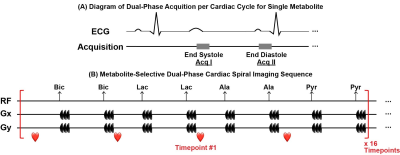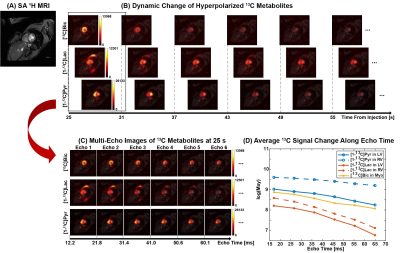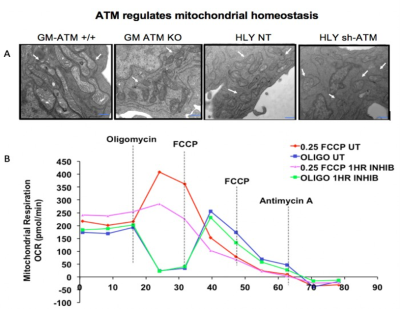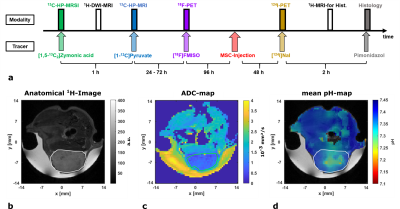Digital Posters
Hyperpolarization: Non-Gas
ISMRM & SMRT Annual Meeting • 15-20 May 2021

| Concurrent 2 | 13:00 - 14:00 |
 |
3577. |
Dual-Phase Imaging of Cardiac Metabolism using Hyperpolarized [1-13C]Pyruvate
Junjie Ma1, Craig R. Malloy1,2,3, Crystal E. Harrison1, James Ratnakar1, Galen D. Reed4, Vlad G. Zaha1,2, and Jae Mo Park1,3,5
1Advanced Imaging Research Center, UT SOUTHWESTERN MEDICAL CENTER, Dallas, TX, United States, 2Internal Medicine, UT Southwestern Medical Center, Dallas, TX, United States, 3Radiology, UT Southwestern Medical Center, Dallas, TX, United States, 4GE Healthcare, Dallas, TX, United States, 5Electrical and Computer Engineering, UT Dallas, Richardson, TX, United States
A dual-phase 13C imaging sequence that acquires multi-echo images of hyperpolarized [1-13C]pyruvate, [1-13C]lactate, [1-13C]alanine and [13C]bicarbonate was implemented to acquire metabolic data at both end systole and end diastole from the human heart in a single injection. The proposed method was demonstrated in short-axis and long-axis ventricle views.
|
||
3578. |
Metabolic response of radiotherapy in patient-derived glioblastoma xenografts using hyperpolarized magnetic resonance
Travis Salzillo1, Vimbai Mawoneke2, Joseph Weygand2, Akaanksh Shetty2, Joy Gumin3, Niki Zacharias2, Seth Gammon2, David Piwnica-Worms2, Gregory Fuller4, Christopher Logothetis5, Frederick Lang3, and Pratip Bhattacharya2
1Radiation Oncology, University of Texas MD Anderson Cancer Center, Houston, TX, United States, 2Cancer Systems Imaging, University of Texas MD Anderson Cancer Center, Houston, TX, United States, 3Neurosurgery, University of Texas MD Anderson Cancer Center, Houston, TX, United States, 4Pathology, University of Texas MD Anderson Cancer Center, Houston, TX, United States, 5Genitourinary Medical Oncology, University of Texas MD Anderson Cancer Center, Houston, TX, United States
Glioblastoma is an aggressive cancer with a median survival of 16 months. Thus, waiting for changes in tumor volume to determine prognosis is too slow to benefit the patient. In this study, we show that in vivo measurements of tumor metabolism with hyperpolarized magnetic resonance can detect changes more rapidly and reliably than conventional anatomic MRI throughout all stages of tumor progression. These data are supported through ex vivo metabolic profiling. Interpretation of these results demonstrate the value that hyperpolarized magnetic resonance can bring to the clinic by addressing specific challenges encountered throughout the the care of glioblastoma patients.
|
|||
3579. |
Hyperpolarized 13C MRI of Fumarate Metabolism for Imaging Necrosis in Hepatitis Mice by Parahydrogen-induced Polarization.
Shingo Matsumoto1, Neil J. Stewart1, Hitomi Nakano1, Takuya Hashimoto2, and Hiroshi Hirata1
1Information Science and Technologies, Hokkaido University, Sapporo, Japan, 2Department of Chemistry, Chiba University, Chiba, Japan
Hyperpolarized [1-13C]fumarate is a promising MRI biomarker for cellular necrosis, which plays an important role in various diseases and cancer treatment response. To demonstrate the feasibility of hyperpolarized MRI of [1-13C]fumarate metabolism using parahydrogen-induced polarization (PHIP) – a low-cost alternative to dissolution dynamic nuclear polarization (dDNP), a cost-effective synthetic pathway for high-yield production of a fumarate precursor [1-13C]acetylenedicarboxylate was developed. A simple hydrogenative PHIP set-up was used to generate hyperpolarized [1-13C]fumarate at sufficient polarization and concentration for in vivo [1-13C]fumarate metabolic MRS/MRI in acetaminophen-induced murine model of hepatitis.
|
|||
3580. |
Dependency of glycolytic factors in HCC lactate and alanine flux as measured by hyperpolarized 13C MRI
Qianhui Dou1, Aaron K. Grant1, Cody K. Callahan1, Muneeb Ahmed1, and Leo Lee Tsai1
1Radiology, Beth Israel Deaconess Medical Center, Boston, MA, United States
This study investigated the feasibility of hyperpolarized 13C (h13C) MRI as diagnostic tool to monitor hepatocellular carcinoma (HCC) activity. h13C MRI showed significant increase in pyruvate-lactate conversion and decrease in pyruvate-alanine in N1S1 HCC tumors following stimulation from nearby hepatic radiofrequency ablation, while no such changes were seen with the MCA-RH7777 HCC tumors, despite increased tumor burden or proliferation in both cell lines. The h13C measurements matched mRNA expression patterns of glycolysis-related genes, which were relatively lower for MCA-RH7777. h13C pyruvate MRI may provide insight into malignant tumor behavior but is contingent on the activity of key glycolytic regulators.
|
|||
3581. |
Imaging Treatment Response with Hyperpolarized Pyruvate in Anaplastic Thyroid Carcinoma
Christopher M Walker1, Zhan Xu1, Keith Michel1, Gary Martinez1, Collin J. Harlan1, Jeremy W. Gordon2, Stephanie Carlon1, Sandra Williams1, Freddy Gonzalez1, Stacy Hash1, Jerell Jones1, Asa McCoy1, Brandy Willis1, Michelle
Underwood1, Andrew Day3, Moin Chariwala3, Dao Le4, Gregory Waligorski3, Daniel B. Vigneron2, Dawid Schellingerhout5, Stephen Y. Lai6, and James A. Bankson1
1Imaging Physics, MD Anderson Cancer Center, Houston, TX, United States, 22. Department of Radiology and Biomedical Imaging, University of California San Francisco, San Francisco, San Francisco, CA, United States, 3Center for Advanced Biomedical Imaging, MD Anderson Cancer Center, Houston, TX, United States, 4Nuclear Medicine, MD Anderson Cancer Center, Houston, TX, United States, 5Nueroradiology, MD Anderson Cancer Center, Houston, TX, United States, 6Head and Neck Surgery, MD Anderson Cancer Center, Houston, TX, United States
This case report presents the detection of hyperpolarized lactate production in a patient with anaplastic thyroid carcinoma. Lactate signal was observed following injection of hyperpolarized pyruvate and the signal was well localized to the tumor. The normalized lactate signal was reduced eight days following the onset of systemic therapy with Pembro and Lenvatinib.
|
|||
3582. |
Off-Resonance Correction with Self-Estimated Field Map for Hyperpolarized 13C Metabolic Imaging
Xiaoxi Liu1, Shuyu Tang1,2, Xucheng Zhu1,3, and Peder E.Z. Larson1
1Radiology and Biomedical Imaging, University of California, San Francisco, San Francisco, CA, United States, 2HeartVista, Inc., Los Altos, CA, United States, 3GE Healthcare, Sunnyvale, CA, United States
Hyperpolarized 13C magnetic resonance imaging is a non-invasive imaging tool to assess metabolic process in-vivo that has been most commonly applied to imaging cancer and heart disease. Spiral readout, as a rapid acquisition technique, is commonly used to acquire hyperpolarized metabolic data. However, the spiral readout is sensitive to the off-resonance effect and has blurring artifacts as a result. The blurring also affects the measurement of metabolism. In this project, we investigated two off-resonance correction methods with self-estimated field maps and applied them on different anatomies.
|
|||
3583. |
In Vivo Evaluation of Glutaminase Activity with Hyperpolarized [5-13C,4,4-2H2,5-15N]-L-Glutamine in PDAC
Roozbeh Eskandari1, Arsen Mamakhanyan1, Michelle Saoi2, Kristin L Granlund1, Justin Cross2, Craig B Thompson3, and Kayvan Rahimi Keshari1,4
1Radiology, Memorial Sloan Kettering Cancer Center, New York, NY, United States, 2Memorial Sloan Kettering Cancer Center, New York, NY, United States, 3Cancer Biology & Genetics Program Share, Memorial Sloan Kettering Cancer Center, New York, NY, United States, 4Radiology, Memorial Sloan Kettering, New York, NY, United States
Aberrations in glutaminase enzyme expression are associated with a variety of pathologies, and an in vivo probe to quantify flux through this pathway may provide a new layer of information. We developed a custom-synthesized compound, [5-13C,4,4-2H2,5-15N]-L-Glutamine, as a hyperpolarized MRI probe for glutaminase activity. Triple labeling of glutamine and D2O solvation reduces quadrupolar relaxation and extends both T1 and T2, facilitating in vivo imaging. We were able to acquire 13C spectroscopic data on a subcutaneous PDAC xenograft murine model and detect in vivo conversion of hyperpolarized glutamine to glutamate, which permits further exploration of this imaging probe in the future.
|
|||
3584. |
Magnetic Resonance Imaging Comparisons of Renal Cell Carcinoma Patient-derived Xenografts
Joao Piraquive1, Hongjuan Zhao2, Rosalie Nolley2, Robert Bok1, James D. Brooks2, Donna M. Peehl1, John Kurhanewicz1, and Renuka Sriram1
1Department of Radiology and Biomedical Imaging, University of California San Francisco, University of California San Francisco, San Francisco, CA, United States, 2Department of Urology, Stanford University, Stanford, CA, United States
We demonstrated substantial morphologic and glycolytic metabolic differences using proton and hyperpolarized 13C magnetic resonance imaging, respectively between and within RCC patient derived xenografts (PDXs). Our findings showed substantial inter-PDX differences in tumor growth rates, as well as the cystic and necrotic components. Furthermore, the xenograft (XEN) established from cell lines derived from the PDX showed significant morphological differences from the parent PDX. Interestingly, upon comparison of two subsequent passages of the same PDX, we found that while the morphological similarities persisted, the glycolytic capacity was significantly increased in the latter passage, implying natural selection of the more aggressive cells.
|
|||
3585. |
In Vivo T2* of Hyperpolarized 13C-Metabolites in Human Brain, Heart, Kidney, and Spleen: An Imaging Approach
Junjie Ma1, Crystal E. Harrison1, James Ratnakar1, Galen D. Reed2, Rolf F. Schulte3, Vlad G. Zaha1,4, Craig R. Malloy1,4,5, and Jae Mo Park1,5,6
1Advanced Imaging Research Center, UT SOUTHWESTERN MEDICAL CENTER, Dallas, TX, United States, 2GE Healthcare, Dallas, TX, United States, 3GE Healthcare, Munich, Germany, 4Internal Medicine, UT Southwestern Medical Center, Dallas, TX, United States, 5Radiology, UT Southwestern Medical Center, Dallas, TX, United States, 6Electrical and Computer Engineering, UT Dallas, Richardson, TX, United States
Multi-echo 13C spiral imaging sequence combined with a spectral-spatial radiofrequency pulse can measure T2* of 13C-labeled metabolite signals in vivo. In this study, we measured T2*s of hyperpolarized [1-13C]pyruvate and products in human heart, brain, kidney and spleen.
|
|||
3586. |
Kinetic Analysis of Multi-resolution Hyperpolarized 13C Human Brain MRI
Jasmine Y Graham1, Adam W Autry2, Yaewon Kim2, Robert A Bok2, Yan Li2, Peder EZ Larson1,2, Daniel B Vigneron1,2, and Jeremy W Gordon2
1Bioengineering, UC San Francisco, UC Berkeley, San Francisco, CA, United States, 2Radiology and Biomedical Imaging, UC San Francisco, San Francisco, CA, United States
Utilizing a multi-resolution acquisition for hyperpolarized [1-13C]pyruvate brain MRI (7.5 mm in-plane for pyruvate and 15 mm in-plane resolution for lactate & bicarbonate) minimized partial volume effects from vascular pyruvate signals while maintaining the SNR of the downstream metabolites. In the healthy volunteers studied, higher resolution HP 13C-pyruvate multi-slice EPI images improved the quantification of kinetic rates in the brain. Selected voxels near veins and in white and gray matter showed on average >20% higher kPL using higher resolution pyruvate images, consistent with reduced partial volume contributions from vascular HP 13C-pyruvate.
|
|||
3587. |
A genetic algorithm-optimized hetero-nuclear polarization transfer pulse sequence for metabolic imaging
Vencel Somai1,2, Felix Kreis3, Adam Gaunt1, and Kevin M Brindle1,4
1Cancer Research UK Cambridge Institute, University of Cambridge, Li Ka Shing Centre, Robinson Way, Cambridge, United Kingdom, 2Department of Radiology, University of Cambridge, School of Clinical Medicine Box 218, Cambridge Biomedical Campus, Cambridge, United Kingdom, 3Department of Information Technology and Electrical Engineering, ETH Zurich, Rämistrasse 101, Zurich, Switzerland, 4Department of Biochemistry, University of Cambridge, Tennis Court Road, Cambridge, United Kingdom An optimized polarization transfer pulse designed using a genetic algorithm is presented, which has greater immunity to the effects of B0 and B1 field inhomogeneity and ~2 times lower peak B1 compared to the BINEPT pulse sequence. The optimization provides a simple framework that accounts for finite pulse lengths and relaxation and outputs a shaped pulse on each frequency channel. Performance was tested on a [15N2]urea phantom at thermal equilibrium, where the polarization transferred from protons to 15N was 1.32 times greater than that transferred using BINEPT. Partial transfer of polarization from hyperpolarized 15N to proton was also demonstrated. |
|||
3588. |
DNP Polarizing Agents in Preclinical HP MRS: Influence in the Context of Transient Ischemic Stroke
Thanh Phong Lê1,2, Lara Buscemi3, Mario Lepore4, Lorenz Hirt3, Jean-Noël Hyacinthe1,5, and Mor Mishkovsky2
1Geneva School of Health Sciences, HES-SO University of Applied Sciences and Arts Western Switzerland, Geneva, Switzerland, 2Laboratory of Functional and Metabolic Imaging, EPFL (Swiss Federal Institute of Technology in Lausanne), Lausanne, Switzerland, 3Department of Clinical Neurosciences, Lausanne University Hospital (CHUV) and University of Lausanne (UNIL), Lausanne, Switzerland, 4Center for Biomedical Imaging (CIBM), EPFL, Lausanne, Switzerland, 5Image Guided Intervention Laboratory, University of Geneva (UNIGE), Geneva, Switzerland
Used at low concentration in DNP sample preparations, radicals are typically chemically highly reactive species that could potentially interfere with the biochemical processes assessed in HP MR experiments. In this work, we investigate the influence of the nitroxyl radical TEMPOL on the cerebral metabolic response to a bolus of hyperpolarized [1-13C]lactate in a mouse model of transient ischemic stroke. Our results show that TEMPOL, administered at the same dose as when used as a polarizing agent for DNP, alters substantially the metabolic outcome of the experiment and notably results in a significantly different pyruvate labelling after hyperpolarized lactate infusion.
|
|||
3589. |
Transportable hyperpolarized glucose: protocol for sample extraction and delivery
Andrea Capozzi1, Jan Kilund2, Magnus Karlsson2, Mathilde Hauge Lerche2, and Jan Henrik Ardenkjær-Larsen2
1LIFMET, EPFL, Lausanne, Switzerland, 2Health Technology, Technical University of Denmark, Kgs. Lyngby, Denmark
Our vision is to make it possible to deliver hyperpolarized compounds to MR facilities that currently have no access to hyperpolarization technology. Today this is not the case and represents hyperpolarized-MR via dissolution Dynamic Nuclear Polarization (dDNP) main shortcoming. The reason is intrinsic in the technique and deals with the presence, in the dDNP sample, of organic free radicals necessary to generate the hyperpolarization. Herein, we demonstrate, for the first time, transportation at cryogenic temperature and remote dissolution of hyperpolarized glucose. The core idea of this project is to exploit the non-persistency of UV-induced radicals for dDNP.
|
|||
3590. |
Hyperpolarized [1-13C] pyruvate MR spectroscopic imaging to detect metabolic changes in liver in a MCD rat model of fatty liver disease
Joao Piraquive1, Shubhangi Agarwal1, Robert Bok1, John Kurhanewicz1, Aras Mattis2,3, Jaqueline Maher3,4, Cornelius von Morze5, and Michael A. Ohliger1,3
1Department of Radiology and Biomedical Imaging, University of California San Francisco, University of California San Francisco, San Francisco, CA, United States, 2Department of Pathology, University of California San Francisco, San Francisco, CA, United States, 3Liver center, University of California, San Francisco, CA, United States, 4Department of Medicine, University of California San Francisco, San Francisco, CA, United States, 5Biomedical Magnetic Resonance Laboratory, Washington University School of Medicine, St. Louis, MO, United States
Hyperpolarized 13C MRI was used to noninvasively detect metabolic changes in a rat model of non-alchoholic steatohepatitis. Rats were fed a methionine- and choline-deficient (MCD) diet for up to 18 weeks. In this preliminary study, we showed a significant increase in fat signal fraction and borderline-signifcant decrease in 13C lactate production in rats fed the MCD diet. Findings in this work suggest that HP 13C pyruvate can be a promising tool to monitor noninvasively the progress of fatty liver disease in patients.
|
|||
3591. |
Constrained UNFOLD (CoUNFOLD)-a New Constrained Reconstruction for Hyperpolarized 13C Pyruvate Imaging
Zhan Xu1, Christopher M Walker1, Collin J Harlan1, Keith A Michel1, Gary V Martinez1, and James A Bankson1,2
1Imaging Physics, MD Anderson Cancer Center, Houston, TX, United States, 2UT Health Graduate School of Biomedical Sciences, The University of Texas MD Anderson Cancer, Houston, TX, United States
A new pharmacokinetic-model-based constrained reconstruction method CoUNFOLD is introduced for hyperpolarized 13C pyruvate imaging. This method extended classic UNFOLD method by introducing model constraint which described the signal evolution of multiple substrates. CoUNFOLD successfully accelerated the data acquisition, and the reconstruction was implemented on single channel. An in silico experiment demonstrated the accuracy of reconstruction at a reduction factor of 2. The quantitative estimation of the conversion ratio from pyruvate to lactate was achieved with high accuracy when peak pyruvate SNR was as low as 20
|
|||
3592. |
Hyperpolarized 13C-pyruvate MR imaging in rodent model of ventricular fibrillation cardiac arrest: A feasibility study
Hyeong Yeon Lee1, Najmiddin Mamadjonov2, Nguyen Trong Nguyen2, Luu-Ngoc Do3, Tien Ahn Nguyen3, and Ilwoo Park3,4,5
1Emergency Medicine, Chonnam National University Hospital, Gwangju, Korea, Republic of, 2Biomedical Science, Chonnam National University, Gwangju, Korea, Republic of, 3Radiology, Chonnam National University, Gwangju, Korea, Republic of, 4Radiology, Chonnam National University Hospital, Gwangju, Korea, Republic of, 5Artificial Intelligence Convergence, Chonnam National University, Gwangju, Korea, Republic of
This study demonstrated that hyperpolarized 13C metabolic imaging can identify the metabolic changes within 1 hour of return of spontaneous circulation in rodent model of ventricular fibrillation-induced cardiac arrest. Brain histology performed at 72 hours after ROSC showed marked difference in the levels of neuronal death and reactive astrocyte change between the cardiac arrest model and sham control. The results from this study suggest that this new metabolic imaging technique may provide a unique and noninvasive imaging biomarker for assessing functional changes at early stage of post ROSC and warrant further investigation.
|
|||
3593. |
Accelerating Hyperpolarized 13C Spiral Chemical Shift Imaging with Joint Spectral-Spatial Low Rank Plus Sparse Reconstruction
Minjie Zhu1, Stephen DeVience2, and Dirk Mayer1
1University of Maryland Baltimore, Baltimore, MD, United States, 2Scalar Magnetics, LLC, Cuyahoga Falls, OH, United States
The goal of this study is to incorporate the spectral dimension into the Low Rank Plus Sparse Reconstruction algorithm with application of undersampled dynamic Hyperpolarized 13C imaging. The proposed method can be used to increase temporal and/or spatial resolution without significantly compromising image quality.
|
|||
3594. |
Comparing aspartate and bicarbonate produced from hyperpolarized 1-13C pyruvate as markers of renal gluconeogenic flux
Hikari A. I. Yoshihara1, Arnaud Comment2,3, and Juerg Schwitter4,5
1Laboratory for Functional and Metabolic Imaging, Institute of Physics, Swiss Federal Institute of Technology, Lausanne (EPFL), Lausanne, Switzerland, 2Cancer Research UK Cambridge Institute, University of Cambridge, Cambridge, United Kingdom, 3General Electric Healthcare, Chalfont St Giles, United Kingdom, 4Division of Cardiology, Lausanne University Hospital (CHUV), Lausanne, Switzerland, 5Cardiac MR Center, Lausanne University Hospital (CHUV) and University of Lausanne (UNIL), Lausanne, Switzerland
Labeled metabolites of hyperpolarized 1-13C pyruvate, including aspartate, malate and fumarate are detected in the rat kidney in vivo, indicating the possibility of detecting gluconeogenic flux. Pyruvate-to-bicarbonate conversion in the fasted rat liver is a marker of PEP-CK flux. Fasting resulted in lower bicarbonate and higher aspartate in the kidney. Conversely, treatment with the PEP-CK inhibitor 3-MPA did not affect bicarbonate production but did yield a lower normalized aspartate signal, with a 12-fold reduction in fasted rats. Renal pyruvate-to-bicarbonate conversion is therefore largely attributable to pyruvate hydrogenase flux, while pyruvate-to-aspartate conversion is a potential marker of renal gluconeogenesis.
|
|||
3595. |
Metabolic Role of ATM in Development of Diffuse Large B-cell Lymphoma
Aditya Jhajharia1, Sui Seng Tee1, Maninder Singh1, Sausan Jaber2, Binny Bhandary3, Brian Polster2, Ronald B. Gartenhaus3,4, Kavita Bhalla3, and Dirk Mayer1
1Diagnostic Radiology and Nuclear Medicine, University of Maryland School of Medicine, Baltimore, MD, United States, 2Department of Anesthesiology, University of Maryland, Baltimore, MD, United States, 3Department of Medicine, University of Maryland, Baltimore, MD, United States, 4Veterans Administration Medical Center, Baltimore, MD, United States
Ataxia-telangiectasia mutated (ATM) kinase regulates critical metabolic processes of B-cell lymphoid malignancies. Diffuse large B-cell lymphoma (DLBCL) is clinically a very aggressive tumor subtype. This study investigates the role of ATM in metabolism. Oxygen consumption rate measurements showed decreased respiration in DLBCL cells lacking ATM. MRS of hyperpolarized [1-13C]pyruvate in DLBCL line HLY that were either wild-type or had ATM knocked down showed increased conversion of hyperpolarized pyruvate to lactate in HLY cells lacking ATM. These results indicate that deregulation of mitochondrial structure/function due to ATM deficiency results in metabolic changes and may contribute to the development of cancer.
|
|||
 |
3596. |
Imaging pH, metabolism and hypoxia using hyperpolarized 13C-MRI and [18F]FMISO-PET to predict NIS expression in MSC gene therapy in glioblastoma
Martin Grashei1, Carolin Kitzberger2, Jason G. Skinner1, Sandra Sühnel1, Geoffrey J. Topping1, Elisabeth Bliemsrieder1, Christian Hundshammer1, Katja Steiger3, Peter J. Nelson4, Rainer Glaß5, Wolfgang Weber1, Christine Spitzweg2, and Franz Schilling1
1Department of Nuclear Medicine, Klinikum rechts der Isar, Technical University of Munich, School of Medicine, Munich, Germany, 2Medizinische Klinik und Poliklinik IV-Campus Großhadern, University Hospital of Munich, Ludwig-Maximilians-University Munich, Munich, Germany, 3Department of Pathology, Klinikum rechts der Isar, Technical University of Munich, Munich, Germany, 4Medizinische Klinik und Poliklinik IV, University Hospital of Munich, Ludwig-Maximilians-University Munich, Munich, Germany, 5Neurosurgical Research University Clinics, Ludwig-Maximilians-University Munich and Walter-Brendel-Centre of Experimental Medicine, Munich, Germany
A novel treatment approach for glioblastoma is based on mesenchymal stem cell (MSC)-mediated gene therapies whereby cell accumulation can be influenced by the tumor microenvironment. Here, we demonstrate the ability to image pH, metabolic pyruvate-lactate conversion and hypoxia in glioblastoma using hyperpolarized [1,5-13C2,3,6,6,6-D4]zymonic acid-MRSI, [1-13C]pyruvate-MRI and [18F]FMISO-PET as predictors for hypoxia-targeted sodium-iodide-symporter (NIS)-expression of tumor-infiltrating MSCs assessed by 124I-PET. Observed hypoxia (SUVmean = 0.49±0.05) was confirmed by histology and occurred together with increased lactate-production (AUCmean = 1.14±0.17) and mild acidification (pHmean = 7.34±0.02). This shows to be a suitable
environment for NIS-MSC-activity, thereby allowing efficient therapy.
|
The International Society for Magnetic Resonance in Medicine is accredited by the Accreditation Council for Continuing Medical Education to provide continuing medical education for physicians.